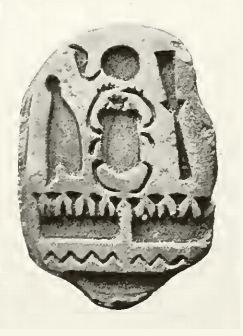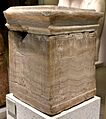Shoshenq I facts for kids
Quick facts for kids Shoshenq I |
|
|---|---|
| Sesonkhosis, Sesonkhis (Σέσωγχις) |
|

Sphinx of king Shoshenq I, Brooklyn Museum, New York City
|
|
| Pharaoh | |
| Reign | 943–922 BC (22nd Dynasty) |
| Predecessor | Psusennes II |
| Successor | Osorkon I |
| Consort | Patareshnes, Karomama A |
| Children | Osorkon I, Iuput A, Nimlot B |
| Father | Nimlot A |
| Mother | Tentsepeh A |
| Died | 922 BC |
Shoshenq I was an important pharaoh of ancient Egypt. He ruled from about 943 to 922 BC. He was the first pharaoh of the Twenty-second Dynasty of Egypt. Shoshenq I came from a group of people called the Meshwesh, who were from Ancient Libya. His father was Nimlot A, a Great Chief of the Ma, and his mother was Tentshepeh A. Many historians believe he is the same king called Shishak in the Hebrew Bible. His great achievements are carved on the Bubastite Portal at Karnak.
Contents
When Shoshenq I Ruled
Historians have studied ancient records to figure out exactly when Shoshenq I was pharaoh. Most agree he ruled from around 943 to 922 BC. This time frame is based on different clues, including a special calendar event from his fifth year as king.
Some experts believe he lived for a few years after his successful military trip to Canaan (an ancient region). This trip happened around 925 BC. If he lived longer, it would mean his reign started a bit earlier. This also helps explain why some of his building projects at the Great Temple of Karnak were not fully finished. Large building projects took a lot of time to plan and start.
Shoshenq I and the Bible
Many people believe Shoshenq I is the same king known as Shishak in the Hebrew Bible. The Bible mentions Shishak in the books of 1 Kings and 2 Chronicles. According to these stories, a man named Jeroboam ran away from King Solomon and stayed with Shishak. After Solomon died, Shishak invaded the kingdom of Judah. This happened during the fifth year of King Rehoboam's rule. The Bible says Shishak took many treasures from the temple that Solomon had built.
Some historians, like Kenneth Kitchen, point to the large amounts of gold and silver that Shoshenq's son, Osorkon I, gave to Egyptian temples. They think this wealth might have come from the treasures taken during the invasion. However, other experts, like Israel Finkelstein, suggest that the story of the looting might be more of a religious tale than a historical fact.
His Family and Rise to Power

Shoshenq I's parents were Nimlot A and Tentsepeh A. His family were leaders of the Meshwesh people, who were Libyans living in Egypt. Before he became pharaoh, Shoshenq I was a very important military leader. He was the Commander-in-Chief of the Egyptian Army. He was also a chief advisor to the pharaoh before him, Psusennes II.
Shoshenq I's uncle, Osorkon the Elder, had already been a pharaoh in an earlier dynasty. So, it was not a complete surprise when Shoshenq I became king. As pharaoh, he made sure his family stayed in power. He chose his oldest son, Osorkon I, to rule after him. He also gave important jobs to his other sons. For example, his second son, Iuput A, became the High Priest of Amun in Thebes. This helped Shoshenq I control different parts of Egypt.
Egypt's Foreign Policy

Shoshenq I was a strong leader who expanded Egypt's power. He led military campaigns into nearby lands in the Middle East. We know this because his name has been found on a statue base in the city of Byblos (in modern-day Lebanon). A piece of a stone monument (a stela) with his name was also found at Megiddo.
He also had lists of conquered cities carved on temple walls at al-Hibah and Karnak. These lists include places in Syria, Philistia, Phoenicia, the Negev, and the Kingdom of Israel. Some of these were ancient Israelite strongholds like Megiddo, Taanach, and Shechem.
However, the list at Karnak does not mention Jerusalem, which the Bible says was a major target. This has led to discussions among historians. Some think the mention of Jerusalem might have been removed from the list over time. Others suggest that King Rehoboam paid Shoshenq a tribute, which saved Jerusalem from being destroyed and therefore from being listed as conquered.
Shoshenq I's military reports are important because they are the first detailed records of Egyptian military action outside Egypt in several centuries.
Ruling Egypt
Shoshenq I changed how Egypt was governed to make his rule stronger. He stopped the tradition where the position of High Priest of Amun was passed down through families. Instead, he and the pharaohs after him chose who would be the High Priest. Often, they chose their own sons. This practice helped them keep control over religious power for about a hundred years.
Where is Shoshenq I Buried?
Shoshenq I was followed by his son Osorkon I. Shoshenq I ruled for 21 years. So far, no one has found the tomb of Shoshenq I. The only object found that is definitely from his burial is a special chest for organs (a canopic chest). This chest is now in a museum in Berlin.
Historians think his tomb might have been robbed a long time ago. They also guess that he might be buried in Tanis or Bubastis. However, there is not much evidence to support these ideas. Some experts suggest he might have been buried in the Ptah temple area in Memphis. Shoshenq I built a lot in Memphis. It is possible his tomb was part of the temple complex there.
Even though his tomb is missing, we know about the burial of one of his important officials. This official, named Djedptahiufankh, was buried in a tomb called DB320. His mummy was found with gold bracelets and other valuable items. This gives us a small idea of the treasures that might have been in Shoshenq I's own tomb.
Images for kids
See also
 In Spanish: Sheshonq I para niños
In Spanish: Sheshonq I para niños




